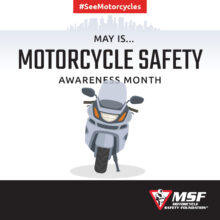Larger models expand scooter popularity
By Matt Bolch
Contributing Writer
Scooters. They’re not just for college kids and environmentalists any more.
Online comments following a Wall Street Journal column in late February on scooters in Paris drew responses from several readers, including attorneys in New York and Chicago who commute by scooter whenever possible. “It is actually cheaper to ride the scooter,” a Chicago attorney wrote. “I have found free parking in the city adjacent to my office and only need a gallon of gas a week. That’s $3.50 a week vs. an $80 CTA (Chicago Transit Authority) month pass.”
High fuel prices, the greater acceptance of scooters as transportation and more powerful models have helped stabilize the scooter segment. “We were up 4 percent year-over-year,” said Glenn Hansen, communications manager at American Suzuki Motor Corp., Brea, Calif. “With the state of the industry where everything else is down, we’re pleased with a 4 percent bump.”
Suzuki’s smallest scooter is the Burgman 400, which features an automatic transmission, large windshield, underseat storage and room for two. Instead of consumers trading in smaller scooters for more-powerful models, Suzuki research indicates buyers are swapping full-size motorcycles for high-powered scooters that can be driven on highways.
“Our scooter owners are older and much more experienced than we’d imagined,” Hansen said. “The average rider is 54-years-old and has 13.4 mean years of riding experience.”
The Genuine Scooter Co. has seen sales in the past half-year jump 55 percent and year-over-year scooter shipments for the first two months of 2008 leap 220 percent, reports Philip McCaleb, CEO of the Chicago-based manufacturer. The company’s largest scooters are 150cc units, and McCaleb says that 125cc and 150cc models comprise 75 percent of company sales.
“We’re sticking with what’s done best for us volume-wise, which is the larger segment,” said McCaleb. He sees a consolidation in the market to a handful of quality brands as buyers turn away from Chinese models and those he terms opportunists.
In terms of where scooters are selling, McCaleb says his top dealers are in Minneapolis, Denver and Salt Lake City, none of which can be considered year-round scooter cities. “The local dealer is the market,” said McCaleb. “We support them with prerecorded audio and video spots and a robust Web site that gets 500,000 unique visitors a month. Fifty-two percent of our customers already have decided on the Genuine brand before going to the dealer.”
While the scooter market reported on by the Motorcycle Industry Council has been flat, sales of Vespas are up 15 percent, says Paolo Timoni, president and CEO of Piaggio Group Americas, based in New York City. Vespa and Aprilia combined in 2007 to account for one of every four scooters sold, Timoni says. As the market matures, the preowned segment is taking on new importance, with Timoni reporting a 56 percent increase in used model sales among Vespa/Piaggio dealers.
“There’s definitely been a change in the American market,” said Timoni. “Historically, the American market has been dominated by 50cc motorscooters that were 70 percent of sales. During the past few years, however, the 50cc category has been declining while the 125cc-and-above category has been growing.”
That’s why he believes last year’s scooter segment sales statistics are an anomoly. The data shows the 50cc category higher and the rest lower amid an overall flat market. The core of sales for Piaggio is in the 125-250cc segment.
Piaggio has been introducing more powerful models, including the MP3 400 and MP3 500, which hit the market earlier this year.
Schwinn Motor Sports also has reported strong sales of the 150cc model it first introduced in late 2006, says George Simone, vice president of the company based in Madison, Wis. The company plans to introduce a 400cc model later this year to capitalize on the demands for more power coming from a larger slice of the scooter segment.
“There are a couple of manufacturers with larger scooters, but there’s not a lot available in the category,” said Simone. “Scooter-specialty dealers without Suzuki franchises don’t have larger scooter models to sell.”
Simone does not believe introducing a larger scooter will cannabilize sales of smaller units because of the specialty drivers’ licenses required for models above 150cc.
“Geography plays somewhat of a role in sales,” noted. “Because of the elevation in Colorado, for example, those riders need a 150, but many people don’t want to go through the training for the motorcycle endorsement.” The company also has seen sales spikes in East Coast resort areas and urban areas in the Southeast that have significant traffic concerns.
Further growth will come from larger-displacement models and those with automatic transmissions since very few Americans drive vehicles with manual transmissions any more, adds Simone.
Yamaha Motor Corp. USA has the 400cc Majesty scooter in its lineup and plans on introducing at least one new model in that segment next year, says Kevin Foley, media relations manager for the Cypress, Calif.-based manufacturer.
“The Majesty 400 has been a very good unit for us, with its ability to seat two-up comfortably and its touring capability,” said Foley. “But our No. 1 seller is the Vino 125, which gets 89 miles per gallon.”
In terms of percentage increase, Yamaha’s C3 scooter, a 50cc unit with a four-stroke, fuel-injected engine, has been a winner in its second year on the market. The company also brought back the 50cc Zuma, which has been in the lineup since the late 1980s but was taken off the market for two years to overcome some emissions issues, Foley says.
“It’s an important segment for us and does account for a good number of units,” Foley said. “The scooter category has done well for us and has been fairly consistent from year to year.”
So while owning a scooter still isn’t on the to-do list of every American, manufacturers have recognized the growing popularity of the category and have responded with significant product introductions in both smaller and larger displacements.
“Scooters have morphed from a really cool toy into really practical transportation,” said McCaleb from Genuine. “The transition has been pushed a little by gas prices and the increased visibility of scooters as a viable transportation alternative.”



